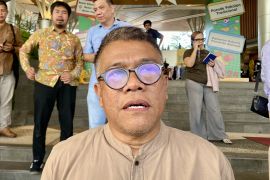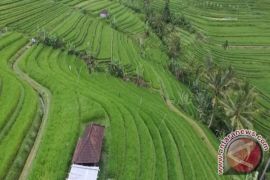The resort island of Bali remains the biggest contributor to the country`s tourism growth.Jakarta (ANTARA News) - The number of tourist arrivals hit a nine-month high of 869,179 in September 2015, shoring up optimism about achieving the target of 10 million tourists, set by the government for this year.
The number of tourists visiting Indonesia in September 2015 represents a 2.19 percent increase, compared to August 2015, and a 9.84 percent rise as compared to September 2014, according to the Central Statistics Agency (BPS).
The resort island of Bali remains the biggest contributor to the countrys tourism growth.
The number of tourists visiting Indonesia via the Ngurah Rai Airport in Bali rose by 7.78 percent in September 2015, with 379.4 thousand visiting in that month, up from 352 thousand in the same month last year.
The airport also saw a 27.04 percent surge in the number of tourist arrivals in September 2015, compared to a month earlier.
However, the number of tourist arrivals at the Soekarno-Hatta Airport dropped apparently because many foreign tourists chose to land at the Ngurah Rai Airport since Mount Raung in Banyuwangi district, East Java, against returned to normalcy.
The number of tourist arrivals in Bali during August 2015 fell by 71,307 to 301,376 from 382,683 in July 2015 due to the fact that airports had to shut down repeatedly because of volcanic ash spewed by Mount Raung that had erupted.
Tourism Minister Arief Yahya said in a press statement released on Monday (Nov 2) that tourist arrivals grew by 9.84 percent in September 2015, not just the highest this year but also a record high in the past five years.
He said the performance of the national tourism industry in September 2015, with tourist arrivals in the first nine months of 2015 being 7,191,771, lifted confidence in surpassing the government-set tourist arrival target of 10 million for this year.
BPS Chairman Suryamin said on Monday that the increase in the number of tourist arrivals was partly the result of the governments policy to provide visa-free facility (BVK) in recent months to tourists from tens of countries.
Yahya said the policy to provide BVK for travelers from 90 countries, compared to 15 countries earlier, has begun showing a positive result, as reflected by the two-digit growth in tourist arrivals in September 2015.
"The more significant impact of BVK will be felt starting next year. As per our projections, the BVK policy will increase the number of tourist arrivals by 1 million in 2016 with foreign exchange earnings estimated at US$1 billion," he said.
Under Presidential Regulation No.104/2015 dated September 23, 2015, the government provided BVK to tourists from 45 countries, bringing to 90 the number of countries offered BVK by Indonesia. The regulation was issued along with two new regulations on yachts and cruises.
The BVK privilege is the second of its kind provided by the government this year.
Yahya said the second phase of BVK policy is a strategic step to lure a significant number of foreign tourists to visit Indonesia after the first phase of BVK successfully raised the number of tourist arrivals from 30 countries between June 10 and August 9, 2015 to 592,748, up 15 percent from 514,171 in the same period last year.
Data from both the Tourism Ministry and BPS showed that the number of tourist arrivals from Egypt in September 2015 grew by 72.60 percent, the United Arab Emirates by 44.51 percent, Saudi Arabia 43.18 percent, Britain 40.78 percent and Germany 38.10 percent.
Cumulatively, Chinese tourists led the growth of tourist arrivals in Indonesia during the January-September 2015 period with 20.04 percent, followed by Egypt 19.45 percent, Britain 13.82 percent, India 10.94 percent, and Germany 6.26 percent.
According to the analysis conducted by the deputy assistant for overseas tourism marketing strategy of the Tourism Ministry , the BVK policy widely popularized abroad and the active promotion of Wonderful Indonesia through the print, electronic, and online media have helped raise the number of tourist arrivals in Indonesia significantly.
In addition, the countrys participation in a number of exhibitions, festivals, bourses, sales missions, and direct promotion, particularly in 18 countries as the focus markets for Indonesian tourism, was another factor that encouraged tourists and resulted in the higher number of tourist arrivals in Indonesia.
It is believed that the high growth of tourist arrivals in September 2015 was owing to a high growth in tourist arrivals from most of the 18 focus markets.
The ministry noted that tourist arrivals from 13 of the 18 focus markets recorded high growth, while the number of tourists from the other five focus markets saw a relatively small decline.
The 13 focus markets which recorded growth were the Middle East (+44.32 percent), Britain (+40.78 percent); Germany (+38.10 percent), the United States (+23.13 percent), Hong Kong (+19,14 percent), Japan (+18.33 percent), India (+17.64 percent), China (+14,58 percent), the Netherlands (+11.59 percent), the Philippines (+8.87 percent); Taiwan (+6.81 percent), France (+3.97 percent) and Singapore (+2.97 percent).
The five focus markets which saw a decline in the number of tourists visiting Indonesia were Russia (-6.43 percent), South Korea (-3.23 percent), Thailand (-1.96 percent), Australia (-1.93 percent) and Malaysia (-1.68 percent).
According to the ministry, the decline in the number of tourist arrivals from the five focus markets was a result of uncertain global economy and pressure on major currencies, including the Malaysian ringgit and the Australian dollar against the US dollar.
With three months still remaining, a period which usually sees a fairly high number of tourist arrivals, particularly from focus markets such as Singapore, Malaysia, Australia and some European countries, the target of 10 million tourist arrivals for this year will be surpassed.(*)
Reporter: Suharto
Editor: Heru Purwanto
Copyright © ANTARA 2015











